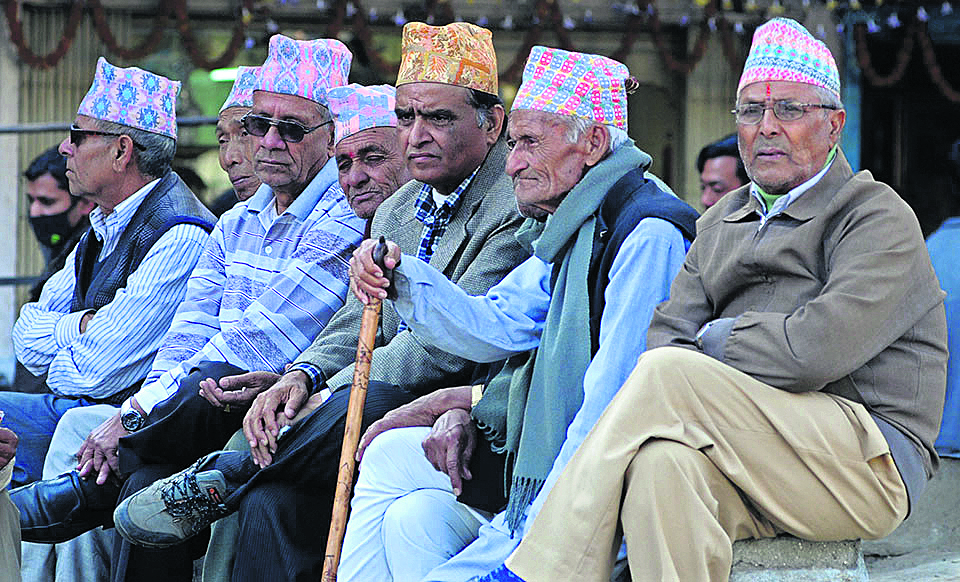
OR
Placing together for care
Published On: February 9, 2020 10:45 AM NPT By: Biranchi Poudyal/ Samikshya Thapa


Biranchi Poudyal/ Samikshya Thapa
Poudyal and Thapa are researchers at Global Initiative for Vivid Empowerment, a Kathmandu based NGOnews@myrepublica.com
More from Author
The elderly people can spend their ending days with orphan children and such intergenerational assimilation can change the social outlook to understand generation gap
The 60-plus population currently constitutes around nine percent of the total population of Nepal, which is expected to rise to 11 percent by 2030. Many studies have proven that grandparents who spend time with children are likely to live longer. But all grandparents in Nepal are not fortunate enough to enjoy the time with budding generation, especially those inside old-age home. They often have no choice than spending lonely life without any work to engage in. Similarly, we have often heard of child trafficking, abuse and other type of malpractice taking place in orphanage around Nepal. Thus, it’s an innovative idea to combine orphanages and old-age homes for the collective benefits of both. This initiation will allow elderly people to voluntarily participate in providing care to children and their involvement will also function as social eye to report any kind of malpractice happening inside orphanage. At social level, such initiation will create an ideal place where children and elderly can co-habit in homely environment by providing necessary support for each other.
A paper entitled “A return to infancy: old age and the second childhood in history” has claimed that elderly phase is the period of second childhood and childish behavior. By bringing two different groups of children together, we can fulfill the emotional as well as social needs of both.
The concept of ‘old-age home cum orphanage’ is simple idea of non-family intergenerational platform that brings together old minds and young inquisitiveness together to interact and spend time for emotional good. It’s very pathetic to see an elderly person spending remaining years of their life in loneliness without any family and it’s equally depressing to watch an orphan child who will never experience the moment of elderly blessing and parental care inside orphanage. With simple initiation of combining elderly care and orphanage, this social necessity gap will be mitigated to a larger extent. Though there may occur some complications as the daily need of elderly and children are different, but with planned institutional practice and proper management old-age home cum orphanage space is not impossible to accomplish.
If not full integration we can go for partly shared space for both as there have already been such practice in international grounds. For example in Japan there is shared playground for elderly and children to enjoy together. Likewise, Afifa Foundation in India has launched an old-age home with an orphanage which has 60-70 elderly people voluntarily helping the institution to take care of children. Bethlehem Intergenerational Center in the United States is a home to day care and senior care facilities, and when these two age groups get together there are benefits to both groups.
This may not seem like some grand project but many researches have already proven that inter-generational interaction can promote the impulse of acceptance and respecting uniqueness of individual in children. The elderly people can spend their ending days with orphan children and such intergenerational assimilation can change the social outlook to understand generation gap. Of course, children are the future of world but that doesn’t mean we should overlook the importance of old generation because their experience can guide children to grow as conscious person in future.
Moreover, the idea of combining either orphanage or childcare home with elderly care is for letting both fulfill each other’s emotional needs. Since very early days Nepali society was thriving amid old age-children reciprocity culture which means the elderly in joint family used to pass time by looking after grandchildren and in the process the children used to receive parental care from elderly. Now in the wake of nuclear family, foreign migration and care-house culture both generations are forced to spend life in different places than home. So the blend of orphanage/childcare with elderly home will allow inter-generational assimilation.
However, ‘old-age home cum orphanage’ is not easy to execute without proper institutional arrangement and integration modality. Thus either the government or national or international NGOs should take the lead of this initiation and make this possible without potential threat on both groups.
Biranchi Poudyal is Senior Researcher at Pioneer Research Center Nepal (IRCN). Samikshya Thapa is Researcher at Global Initiative for Vivid Empowerment (GIVE)
You May Like This

For skin that glows
We are all guilty of buying a lot of skincare products like moisturizers and sunscreen lotions without checking the labels.... Read More...

Everyday essentials: Six things you must do everyday to look your absolute best
Although beauty is quite subjective depending upon the preferences and taste of an individual, there are always small things that... Read More...

Nepal stands atop in South Asia in terms of women coming for health care delivery
KATHMANDU, July 24: Nepal has become the topmost country in the entire South Asia region in terms of the number... Read More...

Just In
- Indians vote in the first phase of the world’s largest election as Modi seeks a third term
- Kushal Dixit selected for London Marathon
- Nepal faces Hong Kong today for ACC Emerging Teams Asia Cup
- 286 new industries registered in Nepal in first nine months of current FY, attracting Rs 165 billion investment
- UML's National Convention Representatives Council meeting today
- Gandaki Province CM assigns ministerial portfolios to Hari Bahadur Chuman and Deepak Manange
- 352 climbers obtain permits to ascend Mount Everest this season
- 16 candidates shortlisted for CEO position at Nepal Tourism Board






_20220508065243.jpg)











Leave A Comment